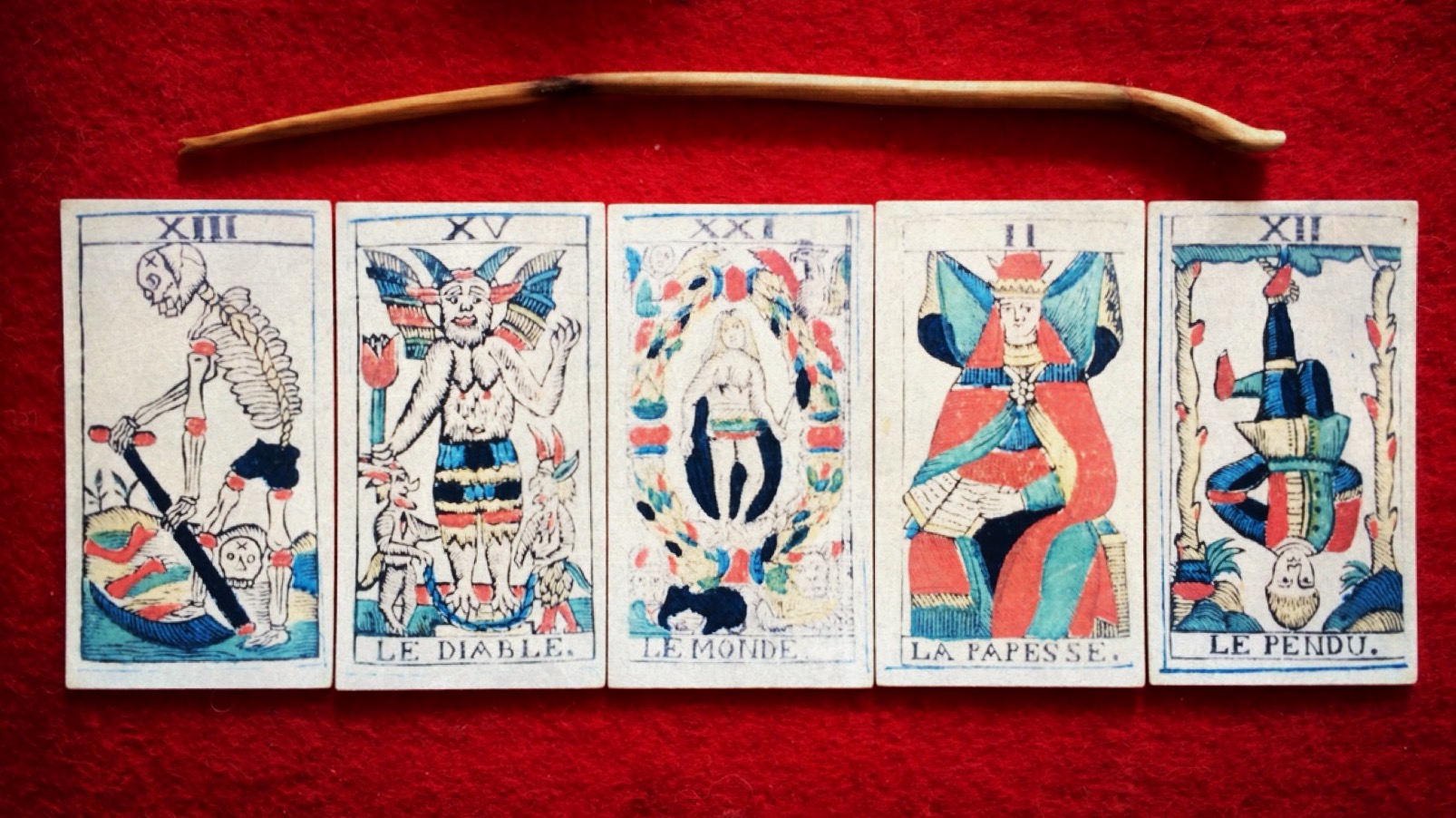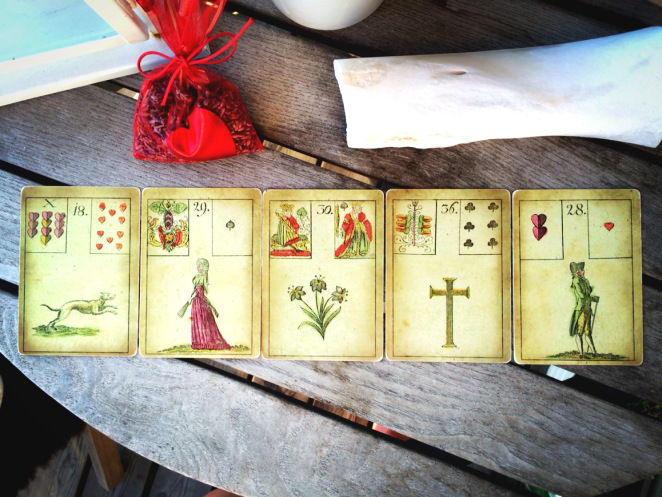I’m often asked: ‘How do you read a 5-card string in line?’
I have just about a ton of examples, from private reading situations and classroom teachings, so it’s difficult to pick just the right ones to offer here. Today, however, I was prompted to make a selection.
I offer two recent examples here, a quick one with the Marseille cards, and another with the Lenormand cards. The first example is from a reading and the second from a teaching in my mentor program.
The questions are similar, coming from women in love experiencing loss, and a certain grief due to continuous attachment. Often the path not taken – choosing the one person over the other – recalls interest in the lost other, and this, in my opinion, always makes for great and insightful readings.
The Mirror Reading
The magic of the 5-card string is that you read it according to the principle of reflection. You start from the inside and move towards the outside.
Basically you read the cards in the order in which you have placed them on the table, either linearly, or in mirror.
For the mirror positions, I follow the classical pattern that goes like this, from left to right (the first card in the center, then the flanking cards, and then the margin cards).
4 | 2 | 1 | 3 | 5
The 5-card Marseille
The Marseille answers the following question:
What does life have to offer the lost other?

Everything. And yet.
We find the World in the center. A half naked woman protected by everything. Nothing goes in, nothing goes out; the wreath makes sure of it. The World is flanked by the Devil, whose gesture goes over the mandorla, bidding the Popesse welcome. These two figures mirror each other, both in size and symmetry. The World may be everything, but compared to the mirroring inner cards, it is rather small and insignificant.
The outer cards speak of a standstill. Death to the left, death to the right. The hanged have a habit of dying, after a rather short period of suspension, and in the absence of immediate rescue.
The center is intense. The dot in the middle, just perfect, flanked by the man who desires and the woman who knows it.
Is this a good life that sitter’s lost lover has? Not really.
Desire and knowledge are separated by the zero of accomplishment. All is here, and nothing is here. Desire is the domain of the Devil. The Devil doesn’t give a damn for perfection, for the protected woman and her guardians. The Devil wants secret knowledge. He is known to trade souls for it. The Popesse sits on it by default.
What is the point of ‘everything,’ if it’s modified by the ‘and yet’?
Here we are with projected nostalgia, and mirroring reflections of the past that bypass temporality. We are here with the paradox of having it all, save for the one you do have, but not to (be)hold: ‘Hello Popesse, I see you see me. I’m excited’.
The Popesse keeps silent. The woman of the book, always the ‘natural’ significator for the inquisitive sitter, handles the Devil as she pleases. When she opens the book, she can summon all the demons. When she closes the book, they all vanish. Her book is open now. The Devil is loose. His tulip, her camellia. These two have an occult relationship. Look at all their sigils . . .
What was the story of the woman in the World again? Ah, too insignificant. She has no agency, and needs none either. Others attend to her image.
But the question was not about her. The question was about the man with past desires, now hanged.
Will the Popesse rescue him? Perhaps she will. She knows how.
5-Card Lenormand
Here’s a another question that I often get from women who are still pining away after lost lovers. As mentioned already, this question fascinates me, as I always get interesting cards that invite me to contemplate the beyond of any immediate reaction calling for: ‘Get over it.’
So the question:
Will our paths cross again?

The Mirror Reading
Now, with the Lenormand tradition, the 5-card layout uses the significator card in the middle, so, again, the middle is central to the reading of this layout.
I, however, don’t place the significator in the center, as I prefer to see what this focus card tells me is of importance. If I just placed the Man or the Woman there, or any other significator card, I would lose sight of what else might be of significance that needs highlighting.
So first we look at the card in the center, the Lily. The flanking cards, the Woman and the Cross, and finally the margin cards, the Dog and the Man.
As you can guess, the way we proceed is by pairing these in that order. Woman+Cross=A sad, sad situation. Dog+Man=Faithful position. The Lily says, ‘Oh Dear.’
The Lily in the center of the layout is quite interesting in relation to the question, for it spells out two things:
- You will meet again because whatever you had together is still there, with its purity intact. We are not with the Scythe or the Coffin here, but with the elegant flower, which, as we all know, is given in appreciation, when we see each other or when we celebrate something. So, the Lily puts us on a track of ‘yes’.
- But. Not now. The Lily is a card of winter, of things taking time to grow into cultivation. This is not the wild field flower that grows generously and abundantly in every ditch.
Looking now at the first pair, we get the idea that if a meeting is not exactly fated – the Cross can easily suggest that – than it will be informed by chagrin. A shame.
The Cross being itself a crossroad, or a crossing of paths, functions as a sign of a future meeting taking place. But again, as this is the Cross, no matter how we turn it, it announces that the crossing of paths will be a painful one.
In a way this situation of sadness is aligned with the Lily. Old wounds never die.
If we look at the final pair in mirror, then we can say that, on the Man’s part, as he’s committed through loyalty to the Woman, he is bound to rise to the occasion of a crossing of paths. He will come to the crossroads – even if the Cross is at his back, suggesting that the past is done.
Now, when all this is said and done, we can start looking at other interesting signs, precisely, such as, why we say that the Cross in the past position indicates a future crossing of paths.
Well, first of all, from the Woman’s perception, the Cross is in her future line. We go with this as she is after all the one asking the question.
But here I also see a certain circularity. If I imagine the cards going in circle, I see the man leaping like a dog, if the woman calls or summons him. She is turned towards the Dog, so she has control over it. Her back is to the Man, but in the circular order of things, she has control over the Man via the Dog.
The Dog+Man in relation to the Woman spells out this following: This man can’t help himself. He responds to this woman like a dog responds to his master, per instinct, automatically, and without delay.
The Man himself is not aware of the power this Woman has over him. He thinks he is free, but he is not. He is bound to the Cross. The Cross is right behind him. So we can infer he’s in denial.
With one person in denial and the other with power to control and dominate, what can we conclude? That the crossing of paths will be of a repetitive nature. The same old same. The Lily suggests that much. The Woman has the Lily at her back, her beauty undying, chaining the Man to his fate. It’s almost like in one of those tragic Edgar Allan Poe short stories.
He gazes into some future, but he’s still the underdog. And the Woman moves towards him, if we consider the linear progression. She doesn’t intend to, but she does it nonetheless by virtue of the nature of things.
Indeed, a sad, sad situation. The Cross between the Lovers, making this relation sublime, yet cold and unapproachable.
Actually, this was quite a sublime set of cards, ever so explicit, popping into the spread when no significators were pulled from the pack.
Now, this was a classical reading.
The Linear Reading
What you can also do is lay the cards in line from left to right, and without intercalation, that is, you go from card 1 down to card 5 in linear fashion.
You also read the cards by paring them, but mostly by following regular sentencing. Here we would read the string thus:
An elegant mistress meets the Man of her fate.
Unless you have a good cause due to observing some symmetries, if this is how you lay the cards down, in line, then that is also how you read them, primarily. Be open to all sorts though.
The Fifth Element
I could go on. The point is that whenever you read a string of five cards, you can think of what reflection means to your perceptions and projections. Let the fifth card in the middle, which is your first card, be the card that anchors the reading.
As they say, however, the margin is always more interesting, so pay attention to the intensity of things moving away from the center, or pressing on it.
It maybe that the secret sits in the middle and knows, but the truth is always on the move, dancing with awareness.
♠
For more such practice with the cards:
- Join the Read like the Devil Club.
- Visit also Aradia Academy and sign up for the newsletter that will keep you informed on upcoming courses and cartomantic activities. Note the Off the Shelf offering that also includes free resources.
- Check out my books on the philosophy and practice of divination at EyeCorner Press.
- Get a reading. When I perform a reading, I also teach, simply because I can’t help myself, so you will be twice served.



I’ve reloaded this page in my browser a couple of times, but the image directly under the words “Will our paths cross again?” isn’t showing. (Feel free to delete this comment.)
Thanks. I’ve fixed it now.
The central card gets to be the focus but it’s also all on its own with no one to pair up with. It knows the secret but has no one to share it with (but if it could share it, then it wouldn’t be much of a secret). Seems lonely.
Are there any benefits to reading with mirrors rather than linearly ( or vice verse)?
The cards themselves must lend themselves to your selection of either the linear or mirror reading. If the cards are symmetrical, as we’ve seen in the first example, then the mirror reading is perfect, as you can follow size and tone and function in reflective relation. Though the linear can always be imposed as well, and vice versa. The context of the event decides what is the most beneficial, but it must not contradict the imagery of the cards, or their formal construction. They must work together, form with content.
Thank you for your insights